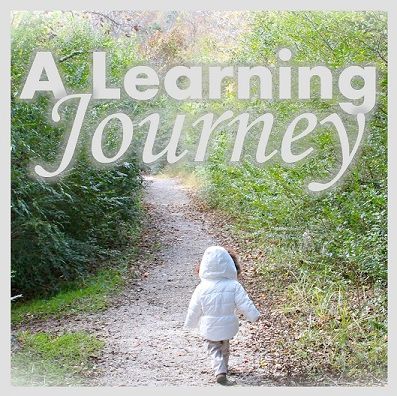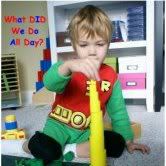Please do not use the pictures or content on this blog without prior permission - the photos are my own. Please provide a link back to my blog if you found something useful or when referring to this content. The use of small items requires close parent or teacher supervision at ALL times. Thank you and enjoy your visit!
Sonrisas Spanish School Curriculum
I most likely won't be blogging on a daily basis about our experiences with this curriculum, but I wanted to share with you an art or shall I say ... drawing activity that we did yesterday.
Calendar and Circle Time
The second day using Sonrisas Spanish School Curriculum went well again. Alyssa gets SO excited when she sees me place the Sonrisas CD in the player. She grabs the sombrero and maracas and gets herself ready to dance. Alyssa also danced with Ana (the girl puppet). We focused on the recommended songs in the manual for the first lesson. Alyssa's favorite song was track #4 "Cabeza, hombros, piernas, pies." Don't forget to listen to their sample songs. We played several songs over and over again because she LOVES dancing and singing. She is also trying to memorize or learn the words to the songs. The tunes are very catchy! We played the same "Me llamo" game and made it a bit sillier using the puppet who was causing a whole lotta trouble. Alyssa was laughing so hard at the puppet. She already knew the appropriate response to the Lesson 1 question. We decided not to choose Spanish names this year. I think we will save that activity for next year when we repeat the curriculum.
Ideas and Suggestions
1.) You could use different size balls and different colored balls to play the game using the appropriate Spanish terms (pequeno, grande, azul, rojo, etc.) before throwing and asking the name game question. Please remember that I haven't figured out how to type with accent marks.
Story Time
We read the story again and I asked her a few comprehension questions in addition to questions about the pictures in Spanish. It was a bit hard for her to understand some of the questions, so I really had to simplify how I asked them. At times I needed to respond or answer for her in Spanish. We also read the book I told you about the other day A mi manera just for fun.
Art Time
This art activity is not part of the Sonrisas Spanish School curriculum - this is one of my own ideas using other available resources. I wanted a game that reviewed the facial features in Spanish. I remembered a game we owned and hadn't played in awhile. Alyssa and I use to play the game Pick and Draw all the time. However, I wanted to do another art activity so I decided to put a twist on this game. I used my photo blocks and Spanish body part Education Cube inserts cards to create a new game. Education Cubes is a member only subscription website, but it is well worth the price I paid for it. I added in a stack of cards for ears that I had drawn. At first, I used a colored dot die that was already prepared from a previous math lesson, but then I remembered that there were Spanish color word card inserts too. I used the ones with the color words typed in the actual color. Next time we will use the black and white inserts since Alyssa already knows her colors in Spanish too. I printed and cut the color word set and Alyssa played the game again. We extended the activity by naming and labeling the character she had drawn in Spanish. One of the characters was named after her and the other after her grandfather. This was so much fun and I am sure we will play the game again to review color and facial terms in Spanish.
On another note, the Pick and Draw game cards are in English - you could replace the top card and make Spanish cards to avoid translation. I wanted to assess Alyssa's knowledge so as she rolled the Spanish body part die she was responsible for figuring out which card to flip over. She knew what all of the words meant in English and it was almost like it was second nature to her. The pictures at the bottom are using Education Cube inserts for both of the dice.
P.S. I love the picture where she is pointing to her ears and saying las orejas.
Click here to read about our experience with the first lesson using the Sonrisas Spanish curriculum.
Please feel free to comment and let me know what you think.
I will also link this activity on the blogs Preschool Corner and 1+1+1=1.
Thanks a bunch,
Tracey M.





































LOVE how you used Pick and Draw and the Education Cubes together! Great idea!!! I will for sure have to check out the Spanish curriculum you are using!
ReplyDeleteHello! Quick question. Sorry if you have already answered it in one of your posts. My 3.5 year-old dd is in a Spanish Immersion preschool 2 mornings a week and will start 3 mornings in the Fall. I would love to look into this program for her, but I do not speak Spanish. Do I need to know Spanish in order to do this with her?
ReplyDeleteThanks!
Steph,
ReplyDeleteSonrisas encourages you to speak Spanish 90% of the time and to use it consistently while using this curriculum. They encourage you to limit the use of English unless necessary during class. "The use of English should be intentional and be a conscious decision" - Sonrisas, 2010. You could use facial expressions, gestures, props, body movement, or visuals to help your child understand the language concept being taught. The biggest thing would be to keep commands and questions simple and direct. I would say that you wouldn't have to be fluent (I am not), but you would need to be familiar with the language to meet this requirement. It really depends on your experience with and how familiar you are with the language. The songs are in Spanish so you could both sing along and learn the words. However, the games played and the books read aloud to your child will be in Spanish. You could familiarize yourself with the language basics and pronunciation from FREE websites found online or purchase a program for at home learning. Then, purchase the curriculum when you feel confident enough to teach your little ones. Remember they are only learning the basics. I hope this helps. You could also contact Brooks or Blue and see what their thoughts are on this subject. Please come back and let me know what they tell you. Thank you for visiting my blog and for asking questions. Hope to hear from you again soon.
Tracey
Jennifer - Thank you! We had so much fun playing this game. Next time we play I will change all of the Pick and Draw card labels so that we are only using Spanish (no English). Thanks for visiting!
ReplyDeleteT
Steph- I think that originally this curriculum was used by Spanish teachers in school classrooms however recently many parents have decided to use it with their children at home. The manual tells you the key vocabulary phrases or words to be taught. It states the main questions you need to focus on and ask during the lessons. Check the sample lesson in the Circle Time box to see what I am talking about and to see if you are comfortable with the format and level of Spanish used. Try it with your child to figure out if this curriculum is meant for your family. Make sure you keep the lessons and environment fun - if you are frustrated with using the language then your child may sense it and become disinterested. It is often easier for young children to learn a second language starting at a very young age. I am so glad to hear that your daughter will be in a Spanish immersion class three days a week - this will help her out tremendously over the years and I love your dedication to want to do more with and for your child.
ReplyDeleteThank you so much for taking the time to answer my question. I think I may have to wait on the program for my dd. It sounds like a great one, but I know I can't speak Spanish 90% of the time. She will continue with her Spanish Immersion class, and then hopefully teach me! Lol.
ReplyDeleteThank you again for responding.
Steph
What I have found with Sonrisas and programs like this one is the challenge for the adult using it when they themselves are not fluent or comfortable in Spanish. Immersion is one way for young children to learn, but it isn't easy for the adults involved if they aren't bilingual.
ReplyDeleteThat is why I developed the Boca Beth Program in the manner in which I did - bilingual method all the way through where Spanish and English are placed alongside one another. Sometimes called the addition method of learning or the parallel method, there is a point of reference for both child and adult when being introduced to the target language.
Both methods work - it's a personal preference: immersion or bilingual. Hope this helps to set you on a happy second language journey road.
Beth, thank you for responding to this post. I am so happy that you stopped by!! I agree ... I believe both immersion and bilingual methods work depending on family preferences and experiences with the language. I think it is important that families know that there is more than one method to teach Spanish. I am very eclectic and enjoy teaching with different methods and curriculums in order to find out what works BEST for my daughter. I am lucky to be able to use the Sonrisas Curriculum and if I didn't have background knowledge with the Spanish language - it most likely would be more difficult for me to use the curriculum. As for now we are enjoying Sonrisas and we can't wait to dive into your beginner's backpack learning set. I hope to hear back from you soon.
ReplyDelete